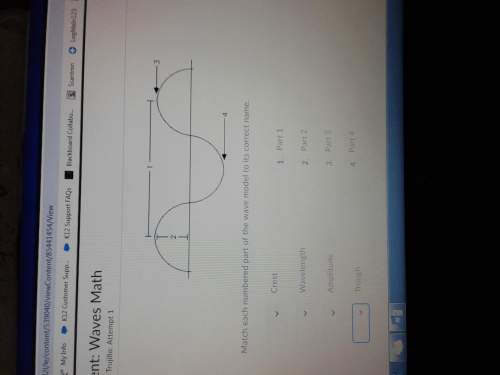
Physics, 30.07.2019 14:30 jaylafennell101
Acrane is used to swing a 450 kg wrecking ball into a 500 kg wall. the crane takes 5 s to push the ball into the building. the crane provides 2000 n of force. the ball is left moving 10 m/s after the collision. how fast is the wall moving afterwards? * how does the kinetic energy change in the crane problem? 1. ke increases 2. ke decreases 3. ke stays the same what type of collision is this? elasti inelastic

Answers: 1


Another question on Physics

Physics, 22.06.2019 01:00
First, launch the video below. you will be asked to use your knowledge of physics to predict the outcome of an experiment. then, close the video window and answer the question at right. you can watch the video again at any point. part a as in the video, we apply a charge +q to the half-shell that carries the electroscope. this time, we also apply a charge –q to the other half-shell. when we bring the two halves together, we observe that the electroscope discharges, just as in the video. what does the electroscope needle do when you separate the two half-shells again? view available hint(s) as in the video, we apply a charge + to the half-shell that carries the electroscope. this time, we also apply a charge – to the other half-shell. when we bring the two halves together, we observe that the electroscope discharges, just as in the video. what does the electroscope needle do when you separate the two half-shells again? it deflects more than it did at the end of the video. it deflects the same amount as at end of the video. it does not deflect at all. it deflects less than it did at the end of the video. submit
Answers: 2

Physics, 22.06.2019 17:00
In the future, people will only enjoy one sport: electrodisc. in this sport, you gain points when you cause metallic discs hovering on a field to exchange charge. you are an electrodisc player playing the popular four disc variant. the disks have charges of qa = −8.0 µc, qb = −2.0 µc, qc = +5.0 µc, and qd = +12.0 µc. (1) you bring two disks together and then separate them. you measure the resulting charge of these two disks and find that it is +5.0 µc per disk. which two disks did you bring together? (a) a and b (b) a and c (c)a and d (d)b and c(e) b and d (f) c and d. (2) you bring three disks together and then separate them. you measure the resulting charge of these three disks and find that it is +3.0 µc per disk. which three disks did you bring together? a, b, and c (a) a, b, and d (c) a, c, and d (d) b, c, and d. (3) given the resulting charge of each disk measured in (b) is +3.0 µc, how many electrons would you need to add to a disk of this charge to electrically neutralize it? electrons
Answers: 3

Physics, 22.06.2019 20:30
Suppose a force of 60 n is required to stretch and hold a spring 0.1 m from its equilibrium position. a. assuming the spring obeys hooke's law, find the spring constant k. b. how much work is required to compress the spring 0.5 m from its equilibrium position? c. how much work is required to stretch the spring 0.6 m from its equilibrium position? d. how much additional work is required to stretch the spring 0.1 m if it has already been stretched 0.1 m from its equilibrium? a. kequals 600
Answers: 2

Physics, 22.06.2019 22:10
7. see worksheet 1 for values of variables x1, x2 and x3 and answer the following questions: a. for each variable find the mean, median, coefficient of skewness, range and population standard deviation. b. compared to variable x1, how are the mean and median affected by extreme values (outliers) seen in x2 and x3. c. is the median or mean the better measure of location for x2 and x3? explain. d. explain the differences in the magnitudes of the skewness coefficients for the three variables. e. what is the relationship between the range and standard deviation looking across the three variables?
Answers: 1
You know the right answer?
Acrane is used to swing a 450 kg wrecking ball into a 500 kg wall. the crane takes 5 s to push the b...
Questions

History, 08.07.2019 12:30

History, 08.07.2019 12:30


Chemistry, 08.07.2019 12:30


Biology, 08.07.2019 12:30

Mathematics, 08.07.2019 12:30






History, 08.07.2019 12:30



History, 08.07.2019 12:30


Mathematics, 08.07.2019 12:30


Biology, 08.07.2019 12:30










